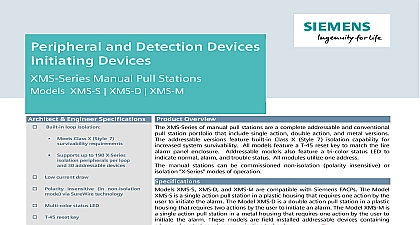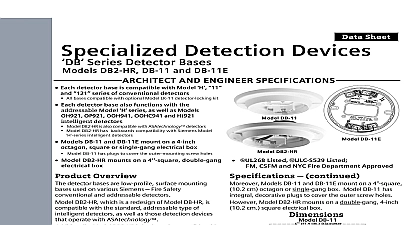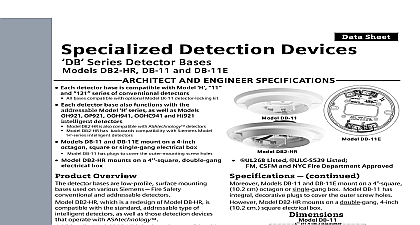Siemens Vesda OSE-HPW, OSE-SP, OSE-SPW, OSI-10, OSI-90, OSID-INST, OSP-001, OSP-002, and VKT-301, Data Sheet

File Preview
Click below to download for free
Click below to download for free
File Data
| Name | siemens-vesda-ose-hpw-ose-sp-ose-spw-osi-10-osi-90-osid-inst-osp-001-osp-002-and-vkt-301-data-sheet-0278415693.pdf |
|---|---|
| Type | |
| Size | 1.50 MB |
| Downloads |
Text Preview
s Series Smoke Imaging Detection OSID Imager OSE HPW OSE SP OSE SPW OSI 10 OSI 90 OSP 001 OSP 002 and VKT 301 AND ENGINEER SPECIFICATIONS Sheet Safety Products Conventional alarm interface for precise with Siemens Fire Safety control panels FACPs Two 2 model types available Imager for 7 coverage 7 has highest detection range 450 ft 137.2m Imager for 80 coverage High false alarm immunity Dust and intrusive solid object rejection Easy alignment with large adjustment and angles Status light emitting diode LED indicators for ON Alarm Trouble event commands Automatic commissioning of 10 minutes Tolerant of alignment drift No need for precise alignment DIP switch configuration Overview Smoke Imaging Detection OSID from Fire Safety is the latest in projected beam detection Basically OSID is used to replace any receiver combination and reflector in a arrangement The most common consists of one 1 imager and one 1 NFPA 72 rules for beam detector spacing apply to OSID usage OSID series of detectors measures the level of entering beams of light projected over an area protection Each OSID imager can detect up to six emitters providing a wide coverage area the OSID series of detectors through its of advanced dual wavelength projected beams optical imaging technology provides a low cost and easy to install solution that overcomes beam detection issues such as false alarm Industry Inc Technologies Division Simple basic maintenance requirements Three 3 selectable alarm thresholds UL268 Listed ULC S529 Listed for OSID detection mentioned smoke technology have been developed for the series of detectors dual wavelength particle and optical imaging dual wavelength particle detection the beam from each emitter contains a distinctive of ultraviolet UV and infrared IR pulses synchronize with the respective imager thus the rejection of any unwanted light sources the dual wavelength process allows OSID detector to decipher particle sizes via use of two 2 wavelengths of light to detect The shorter UV wavelength interacts with small and large particles while the IR wavelength is affected only by larger Imagers 1177 provide results precise Overview continued path loss measurements enable detector measurements as it rejects the presence dust particles or solid intruding objects the Optical imaging enhancement the OSID provides the detector with a wide viewing for locating and tracking multiple emitters the OSID system a and can for the drift caused by natural shifts in a foundation Optical filtering high speed acquisition and intelligent software algorithms enable the OSID system to provide new levels of and sensitivity with greater immunity to a level lighting variability OSID uses imager technology similar to a camera imager to monitor the position of emitters within its frame If the imager is knocked any of the devices move due to building flex they automatically tracked by the imager software OSID detection overcomes the challenges associated with alignment of conventional detectors and avoids the need for any motorized parts traditional beams can typically tolerate 0.3 of movement OSID is able to monitor up to 2 degrees and Siemens Fire has reliably tested well beyond this limit OSID system consists of up to six 6 emitters 90 imager unit is located along the perimeter of protected area and an imager is mounted of the protected space Model OSI 10 is to detect an emitter on a one to one basis component can be mounted directly to the or must be secured to a wall with the supplied brackets Battery powered emitters with up five years battery life are also available to reduce time and costs each imager a termination card provides all field terminals and DIP switches allow the end user configure the detector for particular applications of the emitter is accomplished via a laser tool to rotate the optical spheres until the beam projected from the alignment tool is close the imager each imager is aligned in a similar field of view FOV to all emitters A Trouble condition is if there is a missing emitter or outside FOV of a given imager The OSID system is to maintain since it is highly tolerant to dust dirt Each device therefore just needs the cleaning of the optical faceplates order for Industry Inc Technologies Division continued fire event data such as Alarm Trouble and ON is communicated through the OSID via Status LEDs dedicated Trouble and Alarm and the Remote Indicator Interface Specific Fault conditions are identified through flashes from the Trouble command LED internal heating option is also provided on the system to prevent condensation on the optical and there is a reset input for enabling an signal to reset the device Data 10 to 131 55 0 to 103 39.4 Humidity 95 non condensing Current 24 VDC nominal during training mode 8mA one 1 emitter seven 7 emitters Current 24 VDC wired Std Power High Power Supply Built in five year warranty battery Supply Relay 20 30 VDC 24 VDC nominal 30VDC Open N O Normally Closed and Closed C dry relay contacts Relay N C and C dry relay contacts 30VDC Wiring 12 26 American Wire Gauge AWG Gauge 4 mm Threshold Levels Low sensitivity earliest Alarm 0.97dB 35 1.87dB Medium Medium sensitivity High Lowest sensitivity maximum to nuisance smoke 3.01dB Angles horizontal vertical Angle Max Weight Lbs 0.82 Kg Horizontal Vertical 10 Of Maximum 10 Options Range Power Minimum Maximum ft 30m 492 ft 150m 111 ft 34m ft 6m 10 Range Power Minimum Maximum 10 223 ft 68m denotes maximum distances measured ft 12m the center FOV of the Imager Industry Inc Technologies Division for Ordering Smoke Imaging Detection OSID that sends infrared ultraviolet coded signals to the imager coverage rated at 24VDC Imager that sends infrared ultraviolet light signals to the imager coverage rated at 24VDC Standard power emitter that sends infrared coded light s


